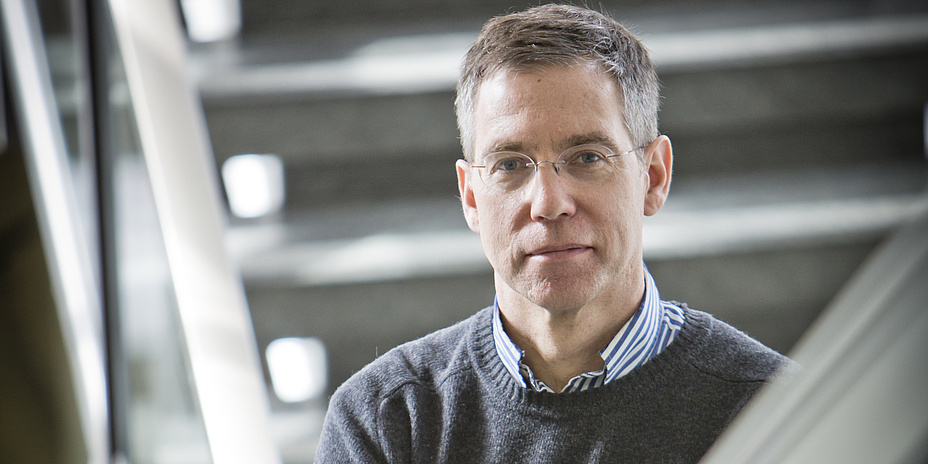The beauty of defects

News+Stories: You primarily work with defects. What are they and why are they so important?
Peter Hadley: In materials science it is often the case that the properties of materials are largely determined by the defects in them.
Take aluminium oxide: in its pure form it is a transparent mineral called corundum. This is a crystal consisting of a repeating pattern of aluminium and oxygen atoms. It is a very hard material that is often used in sandpaper. If some defects are introduced into the periodic arrangement of atoms, it can take on brilliant colours. Adding a small amount of chromium turns the mineral red and it is called ruby. The addition of iron and titanium creates a blue colour and then the mineral is called sapphire. Depending on the defects present, sapphires can also be yellow, purple, orange, and green. So the defects change the optical properties of aluminium oxide.
When I speak to students, they often introduce me to new perspectives or know some fact that I don’t.
Defects also play a large role in determining the mechanical properties of materials. The different kinds of steels consist of iron with some small amounts of other atoms. Pure iron is relatively soft and rusts easily. By adding small quantities of carbon and chromium, the steel is harder and corrosion resistant.
In electronics, we are much more concerned with the electrical properties of a material than the optical or mechanical. Nearly perfect crystals of silicon are the most commonly used semiconducting material. Pure silicon is a terrible conductor – electricity hardly flows through it. If a small amount of dopant atoms such as phosphorus or boron is added, silicon becomes a much better conductor. By selectively introducing the dopants in a pattern, conducting pathways that define the circuit can be made in a non-conducting matrix.
So you put defects in on purpose. Do you also try to prevent them?
Peter Hadley: Yes, we put these defects in on purpose to change the properties of the materials. But there are always many little defects that are not initially intended and can limit a device’s properties. A common defect is a vacancy. Vacancies are sites that are missing an atom. These vacancies can diffuse over time, moving through the crystal. If two vacancies meet, they form a divacancy: two missing atoms. Other single vacancies crash into them, and the process continues until there is a large void in a wire or a device. The current that flows through the device forced to take a detour around the void, and can heat up other parts of the device so much that it eventually fails. We sometimes try to come up with strategies for preventing failures like this.
We usually focus on the fundamental understanding of defects in materials but often we work with companies trying to understand how defects affect their devices or sensors.
We put these defects in on purpose to change the properties of the materials.
Do you work with big tech companies?
Peter Hadley: I advise many students who are involved with a company or an external research institute in some way. My students work with ams, Infineon, Joanneum Research, and the Fraunhofer Institute in Freiburg. They work on solar cells, power transistors, gas sensors, quantum computation, X-ray detectors, laser diodes, and microelectronic packaging.
Is working with students important to you?
Peter Hadley: Oh yes. I learn a lot from my students. Everyone’s knowledge is imperfect and everyone understands things a little bit differently. When I speak to students, they often introduce me to new perspectives or know some fact that I don’t. Usually in my discussions with students we realize that neither of us truly understands an issue and then we come up with a strategy to investigate further. Then they have to come back to me and explain again. In science it’s very important to be able to communicate what you are doing.
I also give a lot of oral exams, and sometimes when I ask a question, the student asks one back, and I have to explain. That’s sometimes harder than I thought it would be (laughs).
I always had the feeling that physics seemed interesting and would work for me.
Do students sometimes surprise you?
Peter Hadley: Frequently they make suggestions or have insights that I have never even thought of. Even students on the introductory courses will sometimes have very good comments.
Thinking back to your time as a student, you could have chosen any field. Why did you choose this one?
Peter Hadley: I think every student gets asked this question (laughs). I think very few people are a hundred percent sure what to study. In my case I always had the feeling that physics seemed interesting and would work for me. Once I got into it, I found out it was.
I studied at Cornell in New York and later at Stanford in California. The first years are fairly abstract – there is a lot of mathematics and you’re just working with a lot of equations. That was very appealing to me, especially when you could describe something complicated in a compact way. While I was studying, the more exotic states of solids like superconductivity were more interesting to me. Silicon seemed like it had already been done. First I worked with superconducting electronics and single-electron devices. But at TU Graz my interests changed back more standard crystalline materials. Now that I’m teaching solid state physics, I really appreciate it more than when I was studying it (laughs).
Peter Hadley heads the Field of Expertise Advanced Materials Sciences, one of TU Graz five Fields of Expertise.
Kontakt
Peter HADLEY
Univ.-Prof. Ph.D.
Institute of Solid State Physics
Petersgasse 16/II
8010 Graz
Tel.: +43 316 873 8967
p.hadley@tugraz.at




